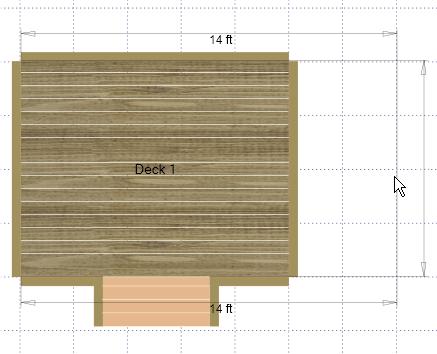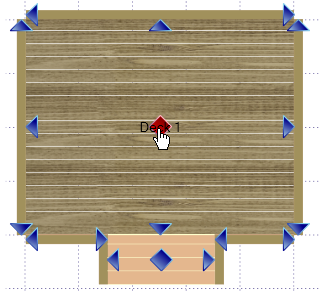
In Plan View, place the mouse pointer on an empty area of the deck surface and double-click the deck to open the Deck Properties dialog. Here you can set the preferred materials, construction method, and other deck options.
NOTE: The Deck Properties dialog can also be accessed by clicking Modify in the Home ribbon, and then selecting Deck from the menu. If multiple decks exist, you will be prompted to choose a deck to edit.

This dialog contains the following tabs:
Construction Method
From this tab you can select from among several construction styles.
You can also choose to add blocking when the lengths of joists exceed 8 feet.
Materials
From this tab you can change the materials used for decking, joists, beams, posts, and fasteners.
To change materials:
Click a material link on the left.
Select a material from the list.
Click OK.
If you have no size preferences and want the system to build the deck using the best sizes for joists, beams and posts, choose NONE for Preferred Sizes. The system uses System Preferences and decking materials when sizing beams, joists and posts.
Footing
Select a post footing style from this tab.
Decking Direction
Select a traditional pattern (horizontal, diagonal, or vertical) or herringbone pattern from this tab.
NOTE: When selecting diagonal decking, you must choose either Horizontal Joists or Vertical Joists. The herringbone option supports adding decorative borders around the deck (Picture Framing).
Loading
Enter dead load and live load in pounds per square foot (psf).
Height
Set the deck height using the sliding bar or by typing the measurements.
NOTE: If you set the deck 32" high or higher, the system prompts you to add railings for safety when you close the Deck Properties dialog.
Bracing
Click the option button beside the preferred bracing method. The default height is 2' for all options and you can enter your own value here.
Other
This tab controls preferences for the following. These settings also appear in the project specs.
Loading
Deflection Factors: Displacement of a structural member (decking, beams, posts) under load. Default = 360
A deflection factor of 240 means that, under load, a structural member (beam, joist, decking board) will deflect (move) no more than 1/240th of its length. Take for example a 10-foot-long beam. 1/240th of 10 feet is ½". When fully loaded (with the dead load and live load used), the center flexes down. If the vertical displacement at the center is ½" or less, then the deflection is permissible with a deflection factor of 240. A higher deflection factor means that less deflection is allowed.
Deflection is what makes decks (or other structures) feel wobbly or feel weak. It is possible to make a structure that is in fact strong enough to hold up under a load, but is still wobbly. Not only do people not like wobbly structures, the continual slight movement may eventually weaken the structure; in wooden structures the connectors or wood-connector joints are the typical points of failure in this case. By ensuring that the structural members meet the deflection test, this problem is avoided. In most cases, the design parameter that actually limits how long a beam or joist can be (before it has to be replaced with a larger one) is the deflection factor.
Miscellaneous:
Joist Overhang: Default = 12 decimal inches
Beam Overhang: Default = 6 decimal inches
Joist Spacing: Default = 16 decimal inches
Decking Gap: Default = 0.25 decimal inches
NOTE: To create new default settings for decks, select the Save as Defaults checkbox.
Change the length of a
deck side by dragging a grip point
(represented by ![]() ) to a new
location on the design grid. Place the mouse pointer over the grip point and hold the left
mouse button to move the deck to a different location on the grid.
) to a new
location on the design grid. Place the mouse pointer over the grip point and hold the left
mouse button to move the deck to a different location on the grid.
NOTE: As you drag an edge, measurements along dimension lines display new values.


To move a deck on the grid, drag it by the grip
point located in the center of the deck, (represented by ![]() ). Place the mouse pointer
over the grip point and
hold the left mouse button to move the deck to a different location on
the grid.
). Place the mouse pointer
over the grip point and
hold the left mouse button to move the deck to a different location on
the grid.
NOTE: A deck attached to a wall cannot be moved.

NOTE: Removing a deck removes all associated structures, such as stairs, railings, etc.